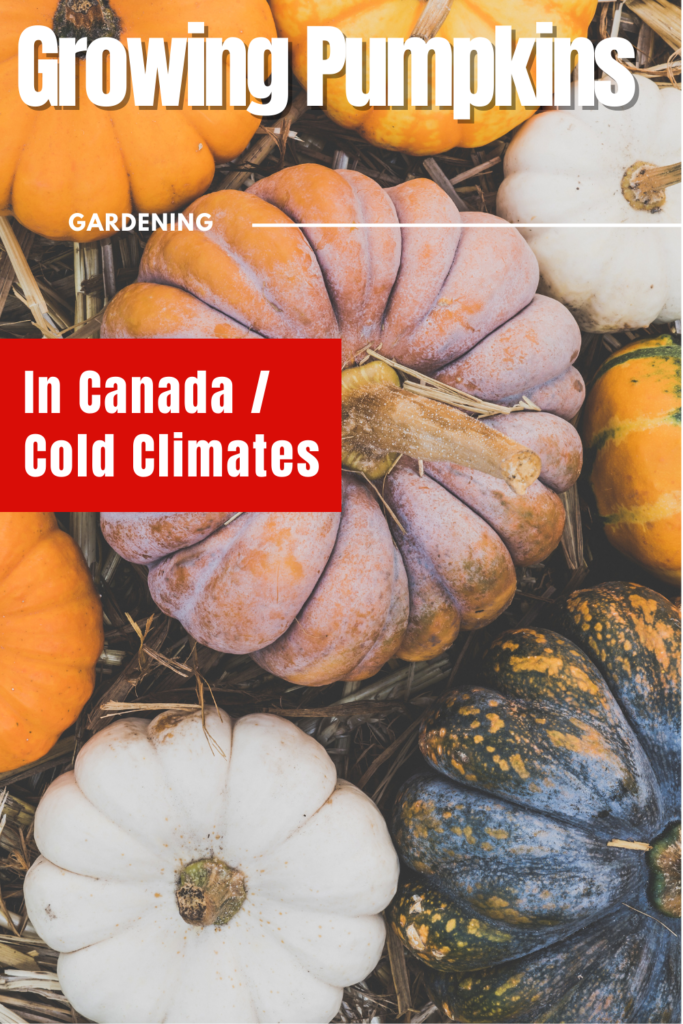- Canada’s Growing Zones Are Changing 2024 - January 12, 2024
- Attracting Wildlife To The Garden - May 16, 2023
- How To Garden Near A Septic Tank - May 9, 2023
Pumpkins are a staple in the fall whether it’s for eating or for decor. Did you know that you can actually grow pumpkins and cooler climates? Let’s take a look at what it means to grow pumpkins in Canada.
Variety Selection
There are a ton of different options when it comes to choosing a pumpkin variety. Some varieties can take upwards of 120 days to grow. This means for those of you in zones 3, 4 and 5 you are unlikely to gain harvest. However, for those of you in a longer growing season, it is possible to grow some of the giant/unique varieties. When growing pumpkins in Canada I like to go with the Neon variety as they are a sure-fire yield.
For the lower zones, you may want to consider getting pumpkins that have a growing degree day somewhere between 70-90 days. These pumpkins tend to be smaller and size but can still be used for carving and eating.
Longer Growing Season Pumpkin Varieties (Zones 6+)
- Giant Atlantic Dill
- Futtuso Black – Looks like something out of a Tim Burtons movie
- Queensland Blue – A beautiful pastel green
- Moranga – Pastel Orange
- Rouge Vif d’Etampes – Dark Orange
- Galeux d’Eysines – Warty Appearance
Short Growing Season Pumpkin Varieties (Zones 2+)
- Neon – Classic Jack-O-Lantern Style
- First Taste Kobcha – Green Stripe
- Jack Be Little – Mini Pumpkins
Starting Pumpkin Seeds Indoors
Pumpkins are one of those plants that do not do well with transplanting. You can try to start your pumpkins indoors early but there are some specific things to consider. You will want to plant approximately 50% more than what you intended to grow. This is to account for die-off during the transplanting process.
One of the best ways to prevent transplant shock and ultimately the death of your pumpkin seedlings is with compostable containers. Using things such as recycled paper, pea pods and other biodegradable pots will help reduce transplant track. The goal here is to plant the entire pot in the soil rather than remove it from the container.
The disruption of the roots tends to be the biggest issue. When we use compostable containers We can plant directly without risking transplant shock.
Vertical Growing Pumpkins
Pumpkins take up a ton of space. For some of the larger size pumpkins, you’re talking a 10-18-foot diameter. One of the best ways to help reduce the amount of land you need is to grow vertically. If your pumpkin variety size is greater than five lbs you want to plant these directly in the ground. Using your front lawn has an area for the pumpkin to grow into to help save on space.
Pumpkin Vine Roots
Pumpkin vines put out roots. These roots help with uptake in moisture and nutrients to help grow the pumpkin. These roots are considered adventitious roots. If you choose to trellis make sure you were only encouraging the growth of one to two pumpkins per plant. The lack of added nutrient capture when vertical growing means the plant can suffer. To help support the fruits you do have, snip away the smaller fruits.
Fertilizer For Pumpkins
Pumpkin plants are huge! And this means they need a lot of water and nutrients. To help provide this you want to consider planting directly into compost or using a slow-release all-purpose. Watering on a regular basis is going to be key for delivering the nutrients.
In some cases daily watering is going to be necessary when the summer heat is in full swing. These plants do not like to the water out and any form of wilting can set the entire plant back. Using mulch and water tape will help ensure the plants receive much-needed water.
Pruning Pumpkins
There is not much in the way of pruning when it comes to growing pumpkins. The exception to this rule would be if you are growing giant versions. If this is the case your would remove all the fruits except for one. The one you leave behind would be the main focus for nourishment. We want to avoid pruning the main portion of the stem whenever possible.
Powdery Mildew
One of the main issues we see with pumpkin plants is powdery mildew. This is overwintered in foliage and therefore you should dispose of any infected debris. Hot composting unfortunately will not illuminate the treat of this and could spread the issue to your entire garden.
If you are noticing powdery mildew build-up you can spray the leaves with milk. Spraying milk on the leaves will help control the infection. If the mildew is particularly bad on some leaves consider removing these entirely! When growing pumpkins in Canada or any vining melon this is a common issue to have.
Harvesting Your Pumpkins
You want to make sure the pumpkins are harvested before the frost hits. Frost will decrease the storage time of the fruits. This means getting them inside prior to a dip in temperatures. If the plants are still not the ideal colour do not stress! They will continue to ripen indoors off of the vine.
Pumpkins are a staple in the fall whether it’s for eating or for decor. Did you know that you can actually grow pumpkins and cooler climates? Let’s take a look at what it means to grow pumpkins in Canada.

